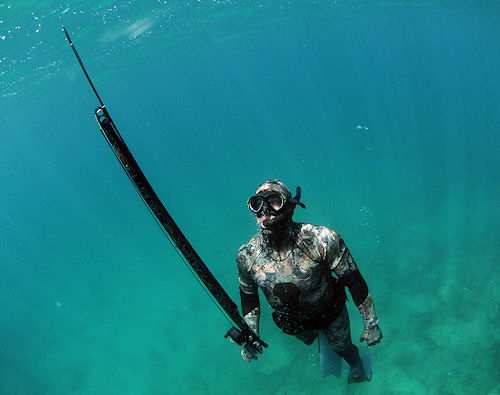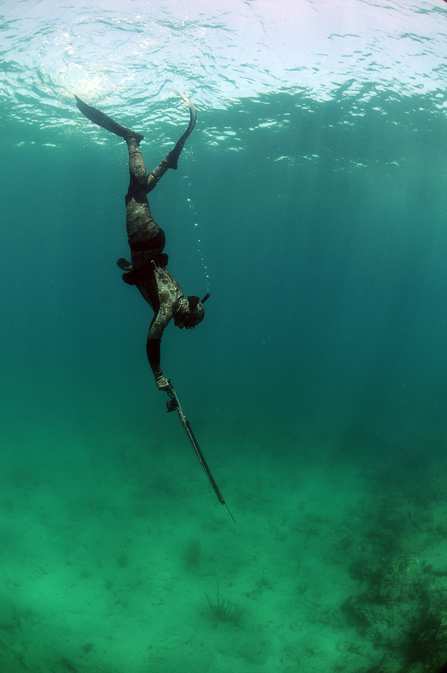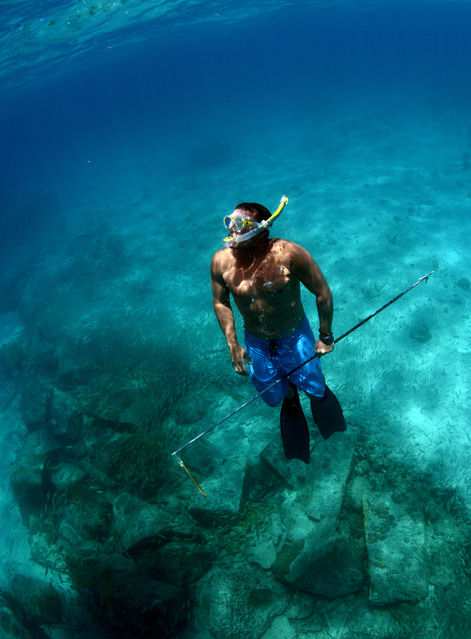Spearfishing – How to Survive a Waterworld Apocalypse
How to Spearfish with a Speargun. Doesn’t matter if seas have risen around the world or if its just your region of the world suddenly under water. If you live near the coast, you can turn to the sea for survival. How to Survive A Waterworld Apocalypse.Included: Spearfishing with Pole Spears and Hawaiian Slings
You know the flick from 1995 where the glaciers melted, the world flooded, and the part-fish, part-man Kevin Costner located the last shred of land based on a tattoo from a little girl’s back.The first question we have to ask ourselves – is this a realistic scenario?
Well, according to this article from the WWF (World Wildlife Fund, not the World Wrestling Federation!) “Even in the least damaging scenario, say a 1°C rise along with an increase in rain and snow, glaciers will continue to lose volume over the coming century.” At the very least, the world waters will RISE only a few feet. Image if it is far worse…
How do you defend and feed yourself in this type of environment?
There is a piece of proven technology that is not new and has been around for thousands of years – A spear.
Fishermen have been using it for centuries to catch their dinner and feed their families. Over the past few hundred years, there has been an improvement to this type of gear, namely the Speargun. If you find yourself in a similar situation, a speargun is a handy tool to have by your side, and a proven way to harvest food from the ocean.
Things to consider before buying your first Speargun
Before you run out to the store, there are a few things you will want to keep in mind for this scenario.The water visibility:
Keep in mind that the longer your gun is, the more powerful it will be. Most people have the tendency to buy the longest gun possible. In my opinion, this is the wrong mentality. You really should take into account WHERE you plan on hunting. In areas with low visibility you will need a shorter gun and in areas large open areas (such as open water) you will need a longer speargun.
At least in our lifetime, a lot of the manmade structures will most likely cause some kind of water pollution upon being flooded. This pollution, will not make it easy to see in the water and thus the visibility will become pretty low.
Arguably, you will need a fairly short gun, one that is around 100cm (3.2 feet) or less. Picture this – you are swimming in the ocean looking for dinner. The water conditions only offer around 8 feet of visibility. When you go spearfishing, the arm that holds the speargun is fully extended in front of your face while you swim. Let’s pretend your arm is 2 feet long, with a gun that is 3 feet long; these two factors combined, your hunting arm will extend to 5 feet, giving you 3 feet to aim and shoot your fish. Any closer the fish will know you are there and swim away.
If you had a gun that was 6 feet long, with your arm fully extended your hunting arm would be 8 feet long. Your gun would be right in the fish’s face, scaring it away.
Should you get a band gun or pneumatic Speargun?
Currently one of the best type of guns you can buy is a pneumatic speargun. They tend to be shorter, very powerful, and are the latest and greatest thing you can buy.The issue is that you want to be able to easily repair your gun. With a band gun, if the elastic breaks you just have to find a new one or rubber tubing to replace it. With a spring and air powered pneumatic, repairs are not that easy and usually require a mechanic.
You can get a multi band gun, but they tend to take a long time to load and are often very long. They can ONLY be used in open water conditions where the water is deep and the fish are REALLY big.
How would a Speargun help you?
Fish for DinnerWith the flooding, fish and other sea creatures will be given a new habitat. The most obvious answer will be that you can use a speargun to catch them.
Protection from Sharks?
It is hard to say what the conditions of these habitats will be like. For example if a coastal city gets flooded, lots of different types of pollution will leak into the ocean, killing a wide variety of wildlife.
Being that they are much smaller, feeder fish would be the first to die in this scenario — leaving their predators, which are much larger and could possibly survive the conditions, with nothing to eat.
When you dive into the water to fix the leak on your boat, do you want a pocket knife, or a man at your back with a speargun to protect you?
Personal Protection
Another obvious scenario is that bullets will be hard to come by. Your speargun could double for self protection and a way to catch dinner. Similar to a crossbow, you can reuse your projectile to defend yourself. Keep in mind you can only use a band gun on the surface and it probably will not be that accurate. Neither type of gun is designed for the surface, but you especially do not want to use a pneumatic out of the water. It fires quickly and will shatter its muzzle if fired outside of the water.
What about eating underwater predators?
Clearly you can use your speargun to shoot a shark or any other type of really large fish. Before you start gunning down sharks, you will have to ask yourself if your speargun is big enough. To catch a fish that is larger than 100 pounds, you will need a multi-band gun.They are exactly what they sound like, larger spearguns, with 2 or more bands that fire a single spear. These types of guns have A LOT of power, tend to be very large, have a longer loading time, and can be very expensive. One brand that specializes in this style of guns is Andre Spearguns. If your goal is survival, chances are a smaller gun would be more practical.
They have a faster loading time and are capable of catching most types of fish. For example, if you are desperately trying to survive in an environment that does not have a lot of food, you want a speargun you can quickly reload. This way if you fire your weapon and miss, you can quickly reload and get back to hunting, whereas with a multi-band gun might take you a few minutes to reload.
Keep in mind if you have a smaller speargun, hunting a shark or any larger fish will likely damage your equipment. For instance, if you shoot a fish that is too big, when it puts up a fight and tries to get away, it might bend or break your speargun.
Technically a medium sized Barracuda that weighs around 70 pounds is still a predator and you do not have to focus on catching sharks. Personally I would try to hunt more passive fish (i.e a large Grouper); you will be able to get plenty of meat from a fish of this size.
If you are truly in a survival situation, hunting anything larger might be more trouble than it is worth. You risk damaging your gear and you lack the refrigeration to store them.
As a side note, I personally do not support hunting sharks for sport. Many species of sharks are quickly diminishing and they play an important role in the ocean. Although I am certainly not an expert in shark biology, from what I understand many species of sharks urinate though their skin. There are species of shark you can eat, but those that release excrement though their skin probably will not taste very good.
Most spearfishermen (also referred to as a “spearos”) view themselves as watermen, a group of people that want to protect the ocean for future generations. Unless it is a dire situation and you have no choice, DO NOT take something from the ocean that you do not plan on consuming.
Currently what most underwater hunters do is use their speargun for protection during a shark encounter. For example, in places like South Africa, running into sharks while spearfishing is somewhat common. It is better to wait at the surface, don’t panic or splash, and keep an eye on the shark until it leaves.
Here is an example of a spearos encounter with a shark from YouTube. Notice how he doesn’t fire his speargun, he simply uses it as a precaution if matters turn for the worst.
https://www.youtube.com/watch?v=hYxmVGhabRk
Where can you learn to use a Speargun and Spearfishing?
If you live fairly close to any body of water (including a few lakes,) chances are there is a spearfishing club in your area. The sport is quickly becoming very popular and there are lots of different communities around the world to help you get started. An example of a community is the South Florida Spearfishing Club, they are a highly organized group of men and women based in Florida who regularly go spearfishing.It is important to at least learn from an experienced spearo how to operate your speargun. After all, they are very dangerous and can possibly harm or kill another individual. Whenever you perform any type of sport that involves going in the ocean, you never want to go alone, always bring a friend or make new ones at your local club.
Is there any type of certification you should get?
If you want to take your spearfishing to the next level, freediving classes are always a good idea. For the most part, most spearos prefer NOT to use scuba tanks. The only gears most spearos use are a mask, snorkel, and a good pair of fins.Freediving is the art of holding one’s breath for extended periods of time while you dive deep. The advantage of becoming certified is that you will learn how to efficiently descend into the depths of the ocean and have longer underwater time. With each dive you will spend more time under the water, giving you more opportunities to catch fish.
It is also worth mentioning that countless people have overestimated their ability and died as a result. Be safe and get the proper training.
As an added bonus, you will be able to catch a wider variety of marine life since you can dive deeper. You will be able to catch lobster, crayfish, oysters, sea urchins, and countless other types of bottom dwellers to consume. Aside from a pair of gloves, you will not require any equipment or spears to catch those bottom dwellers.
Alright enough of the Freediving… Can you just Spearfish with Scuba tanks?
Absolutely. First of all you MUST be PADI certified before you decide to even attempt spearfishing with scuba gear. Most ship wrecks are a haven for fish and underwater wildlife, the abundance of fish makes it a perfect place for underwater hunting. As you may have guessed, many of these wrecks are extremely deep and you’ll need equipment to get anywhere near these deep water sites.Either in a survival or a “just for fun” situation, most would agree the freediving method of Spearfishing would be more effective. When you use tanks, with each dive you will only have about 50 minutes of air. If you did not catch any fish before your air runs out, both you and your stomach are out of luck. When you freedive, you can spearfish literally all day. There is no time limit on your trip or oxygen levels.
What happens if your speargun breaks?
In the worst case scenario, repairing your speargun should be somewhat easy. If you have a band gun, you will have to locate a piece of rubber tubing or elastic material to replace the band. If a different part of your gun breaks, you will probably be out of luck.If you do not have one in the first place or your speargun breaks, there is really no reason to panic. As long as you can locate a piece of rubber tubing or elastic you can still make a pole spear or a Hawaiian sling.
Spearfishing with a Pole Spear
Not all spearfishermen use spearguns, many prefer to use a pole spear. It is a pretty basic piece of equipment that consists of a spear and a long piece of elastic or rubber tubing that is attached to the base of the spear. The concept is that you pull the tubing around half way up the spear; when you see a fish of your liking, you simply release the spear to fire forwards the fish.
Here is a pretty good video of someone explaining how to fire a pole spear.
https://www.youtube.com/watch?v=OsXr9024CV8
The disadvantage of the pole spear is that it cannot fire as far as a speargun. You will have to get fairly close to the fish before you can shoot. That does add an extra element of excitement to hunting. You will have to dive deep, perhaps hide behind a large rock, and wait a few movements for a fish to come into range before catching it.
As far as travel is concerned, in many countries spearguns are illegal. In the Bahamas and Panama, you cannot bring a speargun into their country. If you plan on hunting in their waters, a pole spear is a must.
Enter the Hawaiian Sling
Perhaps the ultimate underwater DIY survival weapon is the Hawaiian Sling. It is basically the spear from a speargun and a piece of rubber tubing. Compared to a pole spear it is much shorter and you can only hunt smaller fish. Given its smaller size, consider it likely that it will fire further than the average pole spear.Below is a pretty good video of how to make a basic Hawaiian sling. As you can see in the video, the young gentlemen makes one in about 15 minutes.
https://www.youtube.com/watch?v=uWLSGbhjzcE
In the video above, he uses metal to make the sling. Realistically you can use about anything that is heavy duty material. For instance, a straight piece of wood with a sharp edge should work just fine.
Final spearfishing thoughts and a quick tip
The best tip we can give you is try really hard not to scare away the fish.When you descend to the depths of the ocean, do not stir up the bottom. If you do, sand and mud will get all over the place, scare off the fish, and limit your visibility.
If you recklessly move though the ocean, you will not catch anything and the fish will stay far away from you. Remember you are trying to become an underwater hunter who tracks fishes and brings home dinner.
If you are reading this on the internet, most likely the underwater apocalypse has yet to arrive. Please fish responsibly and do not remove anything from the ocean that deserves to remain there. Always notify someone where you are going before diving, bring a friend, and be safe!
by Scott Moses





